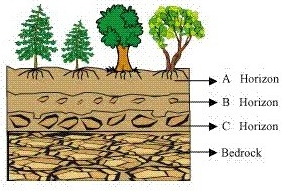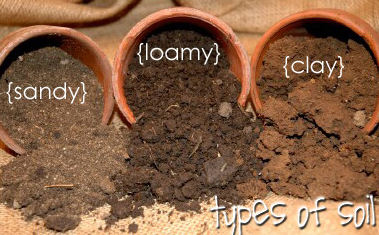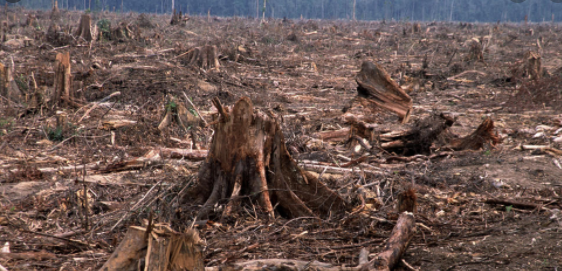
NCERT Solutions For Class 7 Science Chapter 9 Soil, here we are going to give you a summary of NCERT Solutions For Class 7 Science Chapter 9 Soil with questions and answers from the textbook. In this chapter we will study the nature of Soil, its types and we will do some experiments on Soil. Your all doubts from the chapter NCERT Solutions For Class 7 Science Chapter 9 Soil will be cleared from this.
Read more: NCERT Solutions For Class 7 Science Chapter 10 Respiration in Organisms
NCERT Solutions For Class 7 Science Chapter 9 Soil : Introduction
Soil is a very important natural resource. It is home for many organisms. Soil is essential for agriculture. The soil is an inseparable part of our life. Soil helps plants grow. It is a black or dark brown material typically consisting of a mixture of organic remains, clay, and rock particles.
The mixture of rock particles and humus is called the soil.
SOIL TEEMING WITH LIFE
Let us find out if there are organisms living in the soil.
Activity 1 – NCERT Solutions For Class 7 Science Chapter 9 Soil
- Let us collect some soil samples and observe them carefully.
- We can use a hand lens.
- We examine each sample carefully and fill the table:
| S. No. | Soil source | Plants | Animals |
| 1 | Garden soil | Grass, Shrubs | Ant, earthworms |
| 2 | Soil from the roadside | Nil | Nil |
| 3 | Soil from the area where construction is going on | Nil | Nil |
SOIL PROFILE
Soil is composed of distinct layers.
A vertical section through different layers of the soil is called the soil profile. Let us perform the following activity to find out how these layers are arranged. Each layer is different in:
- Texture.
- Colour
- Depth
- Chemical composition.
These layers are referred to as horizons.
Activity 2 – NCERT Solutions For Class 7 Science Chapter 9 Soil
- We take a little soil and break the clumps with our hand to powder it.
- Now let us take a glass tumbler, three quarters filled with water.
- We add a handful of soil to it.
- We stir it well with a stick to dissolve the soil.
- Let it stand undisturbed for some time.
Afterwards, we observe it and answer the following questions:
❏ Do you see layers of particles of different sizes in the glass tumbler?
Ans. Yes, we see layers of particles of different sizes in the glass tumbler.
❏ Draw a diagram showing these layers.
Ans.

❏ Are there some dead rotting leaves or animal remains floating on water?
Ans. Yes, there are some dead rotting leaves or animal remains floating on water. The rotting dead matter in the soil is called humus.
Weathering
Weathering is the process by which soil is formed by the breaking down of rocks by the action of wind, water and climate.
The nature of any soil depends upon the rocks from which it has been weathered down and the type of vegetation that grows in it.
The different layers are:
1. The uppermost horizon is generally dark in colour as it is rich in humus and minerals. Humus makes the soil fertile and provides nutrients to growing plants. This layer is generally soft, porous and can retain more water. It is called the topsoil or the A-horizon. The roots of small plants are embedded entirely in the topsoil.
2. The next layer has a lesser amount of humus but more of minerals. This layer is generally harder and more compact and is called the B-horizon or the middle layer.
3. The third layer is the C-horizon, which is made up of small lumps of rocks with cracks and crevices.
4. Last layer is bedrock, which is hard and difficult to dig with a spade.

SOIL TYPES
On the basis of the proportion of particles of various sizes soil is classified as:
- Sandy soil – greater proportion of big particles. Sandy soil is filled with air. Water can drain quickly through the spaces between the sand particles. So, sandy soils tend to be light, well aerated and rather dry.
- Clayey soil – proportion of fine particles is relatively higher. Clay particles, being much smaller, pack tightly together, leaving little space for air. They are heavy as they hold more water.
- Loamy soil – amount of large and fine particles is about the same. It is the best topsoil for growing plants. Loamy soil is a mixture of sand, clay and another type of soil particle known as silt. It also has humus in it. It has the right water holding capacity for the growth of plants.

Sizes of the particles in a soil have a very important influence on its properties.
Activity 3 – NCERT Solutions For Class 7 Science Chapter 9 Soil
- Let us collect samples of clayey, loamy and sandy soils.
- We take a fistful of soil from one of the samples.
- Let us remove any pebbles, rocks or grass blades from it. Now add water drop by drop and knead the soil.
- Let us add just enough water so that a ball can be made from it, but at the same time it should not be sticky.
- On a flat surface, we roll this ball into a cylinder. We try to make a ring from this cylinder. We repeat this activity with other samples also.
Does the extent to which a soil can be shaped indicate its type?
The answer is yes, the extent to which a soil can be shaped indicate its type.
Clayey soil would be the best for making pots, toys and statues.
PROPERTIES OF SOIL
Let us perform some activities to find the characteristics of the soil.
Percolation rate of water in soil
Movement of water through the soil is known as Percolation. Let us perform the activity below to find out how fast the water passes down the soil.
Activity 4 – NCERT Solutions For Class 7 Science Chapter 9 Soil
- We will need a hollow cylinder or a pipe.
- We ensure that we use pipes of the same diameter for all soil.
- At the place where we collect the soil, we place the pipe about 2 cm deep in the ground. Pour 200 mL water in the pipe slowly. For measuring 200 mL water you can use any empty 200 mL bottle.
- We note the time when you start pouring water.
- When all the water has percolated leaving the pipe empty, note the time again. Let us be careful not to let the water spill over or run down on the outside of the pipe while pouring.
We calculate the rate of percolation by using the following formula:
Percolation rate (mL/min) = amount of water (mL) ÷ percolation time (min)
Let us calculate the rate of percolation in different soil samples.
We arrange the soil samples in the increasing order of the rate of percolation.
Ans. The increasing order is
Sandy soil< loamy soil <clayey soil.
MOISTURE IN SOIL
Let us find out why the air above the land on a hot summer day is so shimmering.
Activity 5 – NCERT Solutions For Class 7 Science Chapter 9 Soil
We take a boiling tube.
- Let us put two spoonful of a soil sample in it. We heat it on a flame and observe it.
- Let us find out what happens upon heating.
Ans. We see water drops. On heating, water in the soil evaporates, moves up and condenses on the cooler inner walls of the upper part of the boiling tube.
On a hot summer day, the vapour coming out of the soil reflect the sunlight and the air above the soil seems to shimmer.
ABSORPTION OF WATER BY SOIL
Let us find out.if all the soils absorb water to the same extent.
Activity 6
- We take a plastic funnel.
- We take a filter paper (or a piece of newspaper sheet), fold and place it.
- Let us weigh 50g of dry, powdered soil and pour it into the funnel.
- Measure a certain amount of water in a measuring cylinder and pour it drop by drop on the soil.
- Let us use a dropper for this purpose. Do not let all the water fall at one spot.
- Let us pour water all over the soil. We keep pouring water till it starts dripping. Subtract the amount of water left in the measuring cylinder from the amount we started with. This is the amount of water retained by the soil.
Let us record our results in our notebook in the following manner:
Weight of soil = 50g
Initial volume of water in the measuring cylinder = U mL
Final volume of water in the measuring cylinder = V mL
Volume of water absorbed by the soil = (U – V) mL
Weight of water absorbed by the soil = (U – V) g
(1 mL of water has weight equal to 1 g)
percentage of water absorbed = [(U – V) x 100] ÷ 50
We repeat this activity with different soil samples.
Let us now answer the following question:
- Which soil would have the highest percolation rate?
Ans. Sandy soil.
2. Which soil would have the lowest percolation rate?
Ans. Clayey soil.
3. Which type of soil will allow water to reach a well faster and in greater amounts?
Ans. Sandy soil.
4. Which type of soil retains the highest amount of water and which retains the least?
Ans. Clayey soil.
5. Can you suggest any method to let more rain water percolate and reach the water underground?
Ans. Method to let more rain water percolate and reach the water underground is to: Dig/loosen the topsoil regularly.
SOIL AND CROPS
Soil is affected by:
- Wind
- Rainfall
- Temperature
- Light
- Humidity
The climatic factors, as well as the components of soil, determine the various types of vegetation and crops that might grow in any region.
Different pulses and its soils are given below:
- Clayey and loamy soils are both suitable for growing cereals like wheat, and gram. Such soils are good at retaining water.
- For paddy, soils rich in clay and organic matter and having a good capacity to retain water are ideal.
- Lentils (masoor) and other pulses, loamy soils, which drain water easily, are required.
- For cotton, sandy loam or loam, which drain water easily. and can hold plenty of air, are more suitable.
- Crops such as wheat are grown in the fine clayey soils, because they are rich in humus and are very fertile.
Which kind of soil would be most suitable for planting rice?
Ans. Clayey soil
Soil with a higher or lower rate of percolation?
Ans. Lowest percolation rate – Clayey soil
SOIL EROSION
The removal of land surface by water, wind or ice is known as erosion. Plant roots firmly bind the soil. In the absence of plants, soil becomes loose. So it can be moved by wind and flowing water. Erosion of soil is more severe in areas of little or no surface vegetation, such as desert or bare lands. So, cutting of trees and deforestation should be prevented and effort should be made to increase the green areas.

NCERT Solutions For Class 7 Science Chapter 9 Soil – Conclusion
In NCERT Solutions For Class 7 Science Chapter 9 Soil we have seen that soil is the main part of agriculture. Different types of soils support different kinds of crops. Without agriculture, food, shelter and clothing are not possible. It supports the growth of plants by holding the roots firmly and supplying water and nutrients. It is the home for many organisms.
NCERT Solutions For Class 7 Science Chapter 9 Soil : EXERCISES FROM TEXTBOOK
Tick the most suitable answer in questions 1 and 2.
1. In addition to the rock particles, the soil contains
(i) air and water
(ii) water and plants
(iii) minerals, organic matter, air and water
(iv) water, air and plants
Ans. (iii) minerals, organic matter, air and water
2. The water holding capacity is the highest in
(i) sandy soil
(ii) clayey soil
(iii) loamy soil
(iv) mixture of sand and loam
Ans. (ii) clayey soil
3. Match the items in Column I with those in Column II:
| Column I | Column II |
| (i) A home for living organisms | (a) Large particles |
| (ii) Upper layer of the soil | (b) All kinds of soil |
| (iii) Sandy soil | (c) Dark in colour |
| (iv) Middle layer of the soil | (d) Small particles and packed tight |
| (v) Clayey soil | (e) Lesser amount of humus |
Ans.
| Column I | Column II |
| (i) A home for living organisms | (b) All kinds of soil |
| (ii) Upper layer of the soil | (c) Dark in colour |
| (iii) Sandy soil | (a) Large particles |
| (iv) Middle layer of the soil | (e) Lesser amount of humus |
| (v) Clayey soil | (d) Small particles and packed tight |
4. Explain how soil is formed.
Ans. Soil is formed by the process of weathering. Weathering is the process by which soil is formed by the breaking down of rocks by the action of wind, water and climate.
More Questions
5. How is clayey soil useful for crops?
Ans. Clayey soil useful for crops because of the following reason:
- Proportion of fine particles is relatively higher.
- Much smaller
- Pack tightly together
- Leaving little space for air.
- They are heavy as they hold more water.
6. List the differences between clayey soil and sandy soil.
| Clayey soil | Sandy soil |
| Greater proportion of fine particles. . | Greater proportion of big particles. |
| Little space for air. | Filled with air. |
| Hold more water as they are packed together. | Water can drain quickly through the spaces between the sand particles. |
| Wet and not dry. | Well aerated and rather dry. |
| Heavy. | Light. |
Sketch the cross section of soil and label the various layers.
Ans.

8. Razia conducted an experiment in the field related to the rate of percolation. She observed that it took 40 min for 200 mL of water to percolate through the soil sample. Calculate the rate of percolation.
Ans. Amount of water = 200 ml
Percolation time = 40 minutes
Percolation rate = amount of water (mL) ÷ percolation time (min)
Therefore, Percolation rate = 5ml/min
9. Explain how soil pollution and soil erosion could be prevented.
Ans. soil pollution and soil erosion could be prevented by:
- Cutting of trees should be prevented
- Deforestation should be prevented
- Effort should be made to increase the green areas.
10. Solve the following crossword puzzle with the clues given:
Across
- 2. Plantation prevents it.
- 5. Use should be banned to avoid soil pollution.
- 6. Type of soil used for making pottery.
- 7. Living organism in the soil.
Down
- 1. In desert soil erosion occurs through.
- 3. Clay and loam are suitable for cereals like.
- 4. This type of soil can hold very little water.
- 5. Collective name for layers of soil.
Ans.
Across:
- 2. Erosion
- 5. Polythene
- 6. Clay
- 7. Earthworm
Down:
- 1. Wind
- 3. Wheat
- 4. Sandy
- 5. Profile